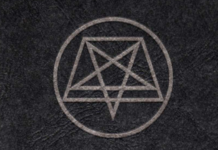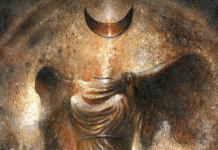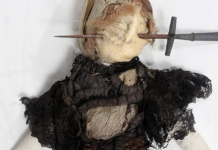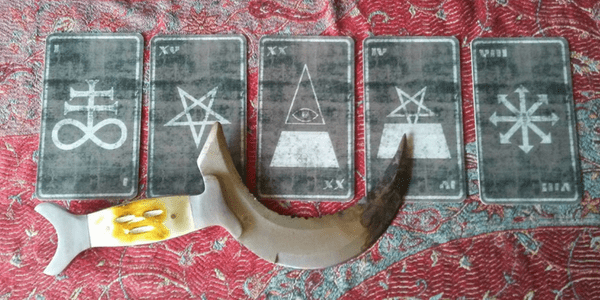
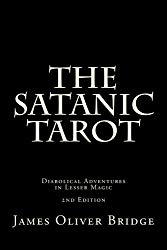 The Satanic Tarot: Diabolical Adventures in Lesser Magic, by James Oliver Bridge
The Satanic Tarot: Diabolical Adventures in Lesser Magic, by James Oliver Bridge
CreateSpace Independent Publishing Platform, 9781983941481, 90 cards, 338 pp., 2018
I have complicated feelings about, The Satanic Tarot: Diabolical Adventures in Lesser Magic, both the deck and its accompanying book. There’s a lot to unpack here, so I’ll start with the basics.
The creator of this innovative deck and book, The Satanic Tarot: Diabolical Adventures in Lesser Magic, is James Oliver Bridge. Left Hand Tarot is his blog,1 and there’s information about ordering the deck at the Satanic Tarot.2 The book is available from Amazon and the entirety of it is posted at either of the author’s websites. Interestingly, he’s also licensed the work under Creative Commons, in order that the cards and book can evolve over time with community contribution. (I’ll note that utilizing creative commons permissions is far beyond my skill set. It seems like a cool idea though!)
I’ll discuss the book and then move on to the actual deck. I was initially confused as to why the book and deck are sold separately, but Bridge tells us that the Satanic techniques and principles he’s developed here can be used with any tarot deck that has the typical 78 card major and minor arcana schema. The first 179 pages of this 338 page book are devoted to examining a Satanic perspective on tarot reading. This section is a fun read. One major criticism I had about the author’s perspective is that he seems to see all tarot readers as professional fortune-tellers — there’s no acknowledgement that the vast majority of tarot readers are reading for themselves (or for personal reasons having nothing to do with making money). This is an oversight, and considering the amount of space Bridge devotes to discussing the role of the fortune teller as it relates to the querent, which he sees as a complex hybrid of entertainer, armchair psychologist, carny, and father confessor, it seems like the author has made assumptions about readers’ motivations for reading tarot in the first place. If we agree that most tarot enthusiasts are amateurs reading for fun, meditation, divination, worship, etc., then a huge portion of this book is more entertaining than useful.
You can definitely see the influence of Anton LaVey, founder of the Church of Satan. Notoriously, LaVey was former carny who considered showmanship itself a Satanic practice. His ideas permeate this book: the Satanic tarot reader functions as a sort of cypher for the querent seeking divinatory services — using every tool in their arsenal to beguile the querent and maintain the appearance of occult authenticity through illusion, manipulation and psychological assessments as necessary. Tarot reading in this book is about telling the subject what they want to hear, in a way that speaks to their particular needs and desires (which may be unconscious or intuited by a gifted tarot reader). I think Bridge sees the practice as potentially altruistic, but mainly as an exchange — generally of money for an emotional or psychological placebo effect. In the author’s words, “Tarot is only a tool to serve the magician.”3 It’s a cynical view of tarot that might be unfamiliar to some readers, and maybe even offensive to others.
The book is divided into five sections. The Book of Lucifer establishes the practice of tarot from the Satanic perspective. Bridge has clearly grappled with his own motivation for reading tarot, and belabours the differences between altruism and entertainment, which I would argue creates a false dichotomy. He writes, “If you are a fortune-teller who persists in the attitude that you are a sacred healer performing divine work, then you are chaining yourself to a fantasy with no basis in reality.”4 I confess, I did enjoy Bridge’s fondness for these types of sweeping pronouncements. I imagine he’s great at his job as a tarot reader, as he projects a jaded confidence, blended with a sort of bemused sympathy for his tarot clients whose motivations he seems to see as often confused, contrary, and emotionally immature.
The next two sections are the Books of Satan and Leviathan. Entertaining reading, but he sticks to the same themes — the power dynamic between the reader and the querent, ethics of tarot, and how theatrics can help contribute to the illusion necessary to dupe your clients. Again, all of this is Satanism 101 for anyone familiar with the writings of Anton LaVey. Don’t get me wrong, there’s lots of fun stuff here. He includes “The Sitters You Meet in Hell” — including the Know Nothing (“I don’t know what to ask. Do you know what I should ask?”) and the Sneaky Squirrel (“I hid an acorn, can you guess where I put it?” — this reader likes to test the readers psychic ability). Another section details the “Nine Satanic Sins for Tarot Readers,” including stupidity, pretentiousness, self-deceit, and herd conformity. Bridge clearly has a sense of humour, and he writes well.
The last two sections are where he gets into reading the cards. The Book of Belial considers how the cards in the deck work together, discussing the major and minor arcana and some principles of Satanic tarot including correspondences, gender, vibration, polarity, and cause and effect. He explains the 21 cards of the major arcana (the 0 card here is the Joker, dismissed from this analysis as irrelevant) through reading the seven groups of three cards in turn, and explains how each card represents either order, tension, or chaos.
Bridge uses similar means to discuss the pips and the court cards in the four suits of the minor arcana. They are read as being cardinal (representing initiative and leadership), fixed (standing still) or mutable (those situations, people or things that respond in kind to influence of other factors and are thus variable). He emphasizes how the cards influence each other, which is helpful for sure.
In the last section, he gets into some spreads, which help demonstrate the relationships between the cards. I liked his emphasis on reading cards together, which is really what makes a reading helpful and worthwhile. He advises that regardless of the size of the spread, you’re always looking at relationships between two cards at a time. This is helpful advice, and I wish more tarot books discussed the importance of looking at patterns and relationships between cards, rather than looking at each of the 78 cards as an individual entity, which can make for an incomprehensible reading.
The last half of the book is confusing. Bridge is clearly tapping into some complex concepts, including hermetic principles of rhythm, correspondences, and vibration, astrology and its 12 houses of influence, numerology, gender, and vibration. It’s bewildering, and considering the complexity he’s trying to introduce, it’s not clear why it’s all packed into the last half. At the beginning of the book, the idea of the Satanic reader as entertainer was comprehensively developed. Frankly, by the time he introduced principles of polarities and magick squares, I was pretty tapped out. It’s overly complex and covered too quickly to absorb enough in order to make meaningful use of the information
The deck includes a printing of 90 cards. The face card gives you a sense of what you’re in for with its warning: “Satan demands study not worship.” This is an aphorism from the Church of Satan, and is meant to discourage devil worship and to instead encourage Satanists to engage in study and critical thought — these ideas are core tenets to Satanism. For anyone interested, the Church of Satan’s website ((Church of Satan, chuchofsatan.com.)) has lots of helpful resources that explicate Satanic principles, which one will recognize in this deck.
The 90 cards include the 78 you’re probably familiar with, although Bridge has reinterpreted the cards in interesting ways. There are 22 major arcana cards, and 56 minor arcana cards in four suits (Bridge uses hearts, clubs, spades and diamonds to correspond to cups, wands, swords and pentacles respectively), and those include the court and numbered pip cards.
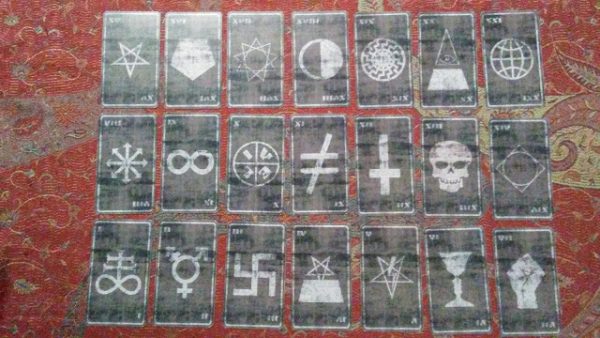
Bridge has taken some liberties with that standard tarot format, and provides rationales for his choices in the book. For example, he calls what are typically pages, “slaves;” and otherwise uses playing card labels for the court cards — so here, the knights are called “jacks.” Additionally, he’s included extra cards: a 23rd major arcana card, “the Squirrel,” which the reader is told can mean anything they wish. He’s also included seven cards that portray spreads a reader can use. This is a nice thing to have available, and something I’m surprised more decks don’t include as a reference. Novel spreads are always fun, and Bridges provides seven including “The Goat of Mendes,” the “Johari Window,” and a “S.W.O.T. Analysis” reading.
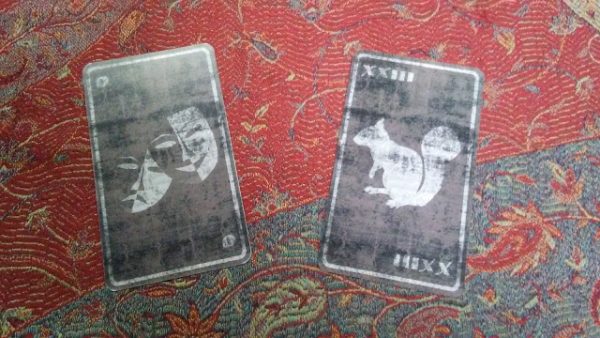
The last three cards are also sort of cool and novel: one card features a white candle (to place on the rights side of the reader in the ritual chamber), another a black candle (to place on the left side of the reader or ritual chamber), and a third features an image of Baphomet (meant to sit between the candle images). As he notes in the guidebook, “This allows you to have all the visual elements of a Satanic altar in a portable format.”5
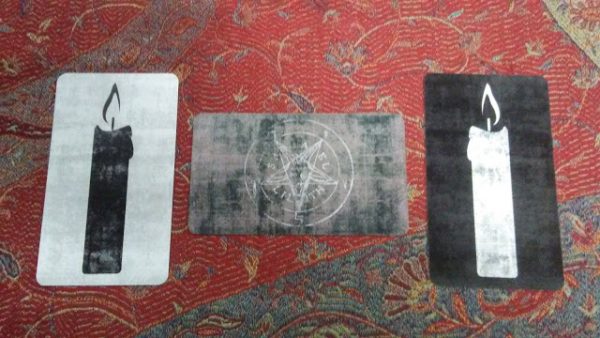
There is lots to like in these cards. The simple imagery is refreshing (although probably more demanding of readers who must remember more about the numbers, suits and correspondences as unable to rely on an artistic depiction), the major arcana has enough similarities to standard tarot decks to be familiar to readers and also to encourage new thought patterns and to challenge readers with different imagery. The cards are a nice size and weight for handling and shuffling. However, I find them a little artless. The tones are muddied, almost with a faded and degraded appearance, though I’m sure this was an aesthetic choice for the creator.
From Bridge’s book, it’s clear he doesn’t take a sentimental or particularly aesthetic approach to reading. He clearly sees tarot cards as a tool that permits a reader to enact something akin to a parlour game, a confidence trick, or a psychological sleight of hand, or perhaps all three. Perhaps this no-nonsense approach explains the lack of artistry in the cards? From my perspective, there are so many wonderful artists working in Satanic and Luciferian themes and images, it seems a pity that a collaboration couldn’t have been achieved, to make Bridge’s vision come to life in a more beautiful way. I’m thinking of artists like those who produce work for the Satanic Temple like Abigail Larson, Luciana Nedelea or Bill Crisafi to name a few. Even a quick Instagram search for #satanicart or #satanicartists turns up a lot of really nice work. I’m sure Bridge had reason for the choices he made with regard to deck artwork, and given that it is a Creative Commons project, it seems he might be open to suggestions about how to make the deck even better.
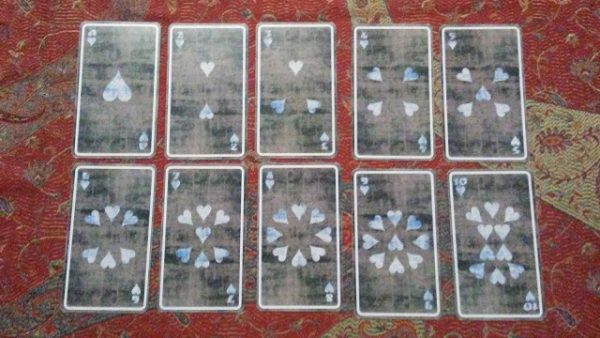
I tried each of the seven readings included in the deck over the course of a week. Given that I couldn’t synthesize all of the interpretive components described by Bridge (I have the houses, pips and suits down from previous tarot study, but as discussed Bridge brought a dizzying array of tools to the interpretation piece of this deck — astrological houses, hermetic correspondences, numerology — to name only a few). I used my own skills to interpret the cards. I will say that I like his major arcana. The inclusion of cards representing Chaos, Inequality, and the Illuminati was cool. I know these archetypes are also embedded in the traditional major arcana, but renaming them adds a certain Satanic flair! I got strong readings from the cards. They seemed to hang together thematically and I found them as useful as any deck in my collection. I can’t see myself developing an emotional connection with these cards though, as I find them so aesthetically displeasing. Maybe that’s part of the point for Bridge?
In conclusion, The Satanic Tarot: Diabolical Adventures in Lesser Magic and the accompanying deck does ask a lot of its users, and that’s probably a good thing. I enjoyed the book, but I wish Bridge could have found a more accessible way to introduce his complex methods for card reading, in order to make it feel less overwhelming for the reader. Turns out, this reader wasn’t quite ready for the study demanded by Satan!
- Left Hand Tarot, lefthandtarot.com. [↩]
- The Satanic Tarot, satanictarot.cards. [↩]
- p. 29 [↩]
- p. 37 [↩]
- p. 335 [↩]


